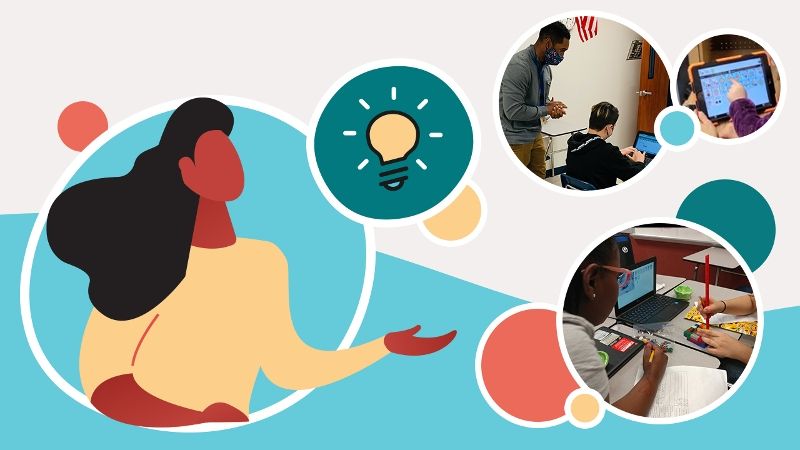Engage Families in Teaching Practices

Get Started Engaging Families in Teaching Practices:
Family engagement is an important component of designing learner-centered experiences. Families can inform educators about an individual’s strengths and preferences. Educators can apply insights provided from family members to create inclusive learning communities.
CITES teaching family engagement practices and action steps to support these practices include:
Engage Families in the Learning Community
Practice: The district considers families part of the learning community and provides guidance for all educators to engage in frequent, direct communication with families of students with disabilities.
Actions to engage families in the learning community:
- Provide guidance for communicating with families: The district provides educators guidance for engaging in regular communication regarding instruction with families of students with disabilities using bi-directional and familiar means (i.e., text message, email, etc.).
- Provide guidance for engaging families in accommodation planning: The district encourages educators to include families in a collaborative planning process to help inform educational accommodations and supports for their child’s education.
Support Families’ Shifting Role
Practice: The district supports the shifting role of parents/caregivers from advocates for their children to helping families become student self-advocacy coaches.
Actions to support the shifting role:
- Provide guidance on family advocacy: The district provides guidance for educators to encourage families to advocate for the learning supports their children require.
- Provide guidance on self-advocacy: The district provides guidance to educators to support families and students with a variety of resources and training to guide students’ transitions to becoming self-advocates and self-determined young adults.
Learn from Our Partners

- Podcast: Family Engagement & Inclusive Technology Practices Podcastexternal site, AEM Center at CAST
- Panel Discussion: Empowering Families in the Digital Age: Building Inclusive Tech Partnershipsexternal site, CITES at CAST
- Webinar: Partnering with Families in the Digital Learning Processexternal site, Center on Parent Information and Resources (CPIR)
- Glossary
Resources
- Family Engagement in Virtual LearningPDF document, CITES at CAST
- Research Shows Home-School Communication is Forever Changedexternal site, Global Family Research Project
- Family Engagement and Cultural Perspectives: Applying Strengths-based Attitudesexternal site, Early Childhood National Centers
- Empowering Families to Improve Student Learningexternal site, West Ed
- Connecting Family Engagement to Student Learningexternal site, Digital Promise
Chris's Story
Chris is a first-grade teacher at an elementary school in a South Atlantic state. One of Chris’ students, Alex, has Autism and fine motor difficulties. Alex uses a voice-output device to communicate because he struggles with verbal communication.
Chris emails Alex’s parents when they cannot figure out how to best meet Alex’s needs on an upcoming assignment or class activity. Chris provides the parents with a copy of the assignment and asks for their feedback on options for modifications and accommodations. Upon receiving parent feedback, Chris updates the assignment or activity instructions to include the accommodations and modifications as choices for all students, not just Alex.
Chris also emails Alex’s parents and the school speech therapist weekly with new vocabulary related to what students will be learning the following week in class. The speech therapist and Alex’s parents add the new words to Alex’s voice-output device and teach him how to access and use those words so that he can participate in class fully.
Supporting Research
- Hamilton, M.B., Stansberry, L., & Pearson, J.N. (2021). Culturally Competent Educational Practices to Support Children with Disabilities and their Families. DADD Online Journal. 8, 114–128
- Harvard Family Research Project. (2013). Tips for administrators, teachers, and families: How to share data effectively. Family Involvement Network of Educators (FINE) Newsletter, 6(3). https://archive.globalfrp.org/var/hfrp/storage/fckeditor/File/7-DataSharingTipSheets-HarvardFamilyResearchProject.pdfexternal site
- Kiger, D., & Herro, D. (2015). Bring your own device: Parental guidance (PG) suggested. TechTrends, 59(5), 51–61. https://doi.org/10.1007/s11528-015-0891-5external site
- Laho, N.S. (2019). Enhancing school-home communication through learning management system adoption: Parent and teacher perceptions and practices. School Community Journal, 29, 117–142.
- Valerie, L. M., & Foss-Swanson, S. (2012). Using family message journals to improve student writing and strengthen the school–home partnership. TEACHING Exceptional Children, 44(3), 40–48. https://doi.org/10.1177/004005991204400305external site